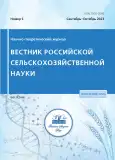Stability assessment of immunobiological medicinal products manufacturing for veterinary use with Shewhart control charts
- Authors: Kotegova K.A1, Zaberezhniy A.D1, Neminushchaya L.A1, Skotnikovа T.A1, Eremets V.I1, Markova E.V1, Grin S.A1, Popova V.M1
-
Affiliations:
- All-Russian Scientific Research and Technological Institute of Biological Industry
- Issue: No 5 (2023)
- Pages: 78-82
- Section: Articles
- URL: https://journals.rcsi.science/2500-2082/article/view/233588
- DOI: https://doi.org/10.31857/2500-2082/2023/5/78-82
- EDN: https://elibrary.ru/XFAONI
- ID: 233588
Cite item
Full Text
Abstract
About the authors
K. A Kotegova
All-Russian Scientific Research and Technological Institute of Biological Industry
Email: kotegovaka@biocombinat.ru
A. D Zaberezhniy
All-Russian Scientific Research and Technological Institute of Biological Industry
L. A Neminushchaya
All-Russian Scientific Research and Technological Institute of Biological Industry
T. A Skotnikovа
All-Russian Scientific Research and Technological Institute of Biological Industry
V. I Eremets
All-Russian Scientific Research and Technological Institute of Biological Industry
E. V Markova
All-Russian Scientific Research and Technological Institute of Biological Industry
S. A Grin
All-Russian Scientific Research and Technological Institute of Biological Industry
V. M Popova
All-Russian Scientific Research and Technological Institute of Biological Industry
References
- Адлер Ю.П., Жулинский С.Ф., Шпер В.Л. Проблемы применения методов статистического управления процессами на отечественных предприятиях // Методы менеджмента качества. 2009. №8. С.36-40.
- Алексеева И.А., Перелыгина О.В., Колышкина Е.Д. Оценка стабильности производства коклюшного компонента АКДС-вакцины по показателям Инфекционной активности и специфической безопасности с использованием карт Шухарта // БИОпрепараты. Профилактика, диагностика, лечение. 2018. №18(4) С.243-248. https://doi.org/10.30895/2221-996X-2018-18-4-243-248
- Алексеева И.А., Перелыгина О.В., Колышкина Е.Д. Оценка стабильности производства коклюшного, дифтерийного и столбнячного компонентов АКДС-вакцины с помощью контрольных карт Шухарта // БИОпрепараты. Профилактика, диагностика, лечение. 2021. №21(4). С.256-265. https://doi.org/10.30895/2221-996X-2021-21-4-256-265
- Васин Л.А., Нечаев Ю.В. Проблемы применения метода Шухарта для мониторинга технологических процессов. // Известия Тульского государственного университета. Технические науки. 2013. №5. С.133-140.
- Дейкин А. Бомбардировка. Как работает российская программа вакцинирования диких животных с воздуха // Коммерсантъ Наука. 2019. № 47. С.14 https://www.kommersant.ru/doc/4134733
- Колышкин В.М., Васильев А.В. Оценка стабильности производства коревой вакцины // Биотехнология. 2008. №1. С.57-63.
- Колышкин В.М., Васильев А.В. Оценка стабильности производства ассоциированной паротитно-коревой вакцины // Биотехнология. 2008. №4. С.64-68.
- Колышкин В.М., Васильев А.В. Оценка стабильности производства паротитной вакцины // Биотехнология. 2008. №5. С.68-75.
- Максимова О.В., Шпер В.Л. Исследование эффективности работы контрольных карт Шухарта // Методы менеджмента качества. 2010. №12. С.40-45.
- Мельник Р.Н. Методы борьбы с бешенством диких животных с использованием малой авиации. Ветеринарный врач. 2020. № 4. С.25-29. doi: 10.33632/1998-698Х.2020-4-25-30
- МЭБ 2021. www.oie.int бешенство (дата обращения 16.06.2022)
- Нуратинов Р.А. Экологическая дивергенция вируса бешенства. // Юг России: экология, развитие. 2013. № 8(4). С.62-72.
- Shewhart W.A. Statistical method from the viewpoint of quality control New York: Dover Publ., Inc. 1986.
- WHO expert consultation on rabies: Third Report. TRS: №1012-2018 (дата обращения 16.06.2022)
- WHO, 2018. Zero by 30: the global strategic plan to end human deaths from dog-mediated rabies by 2030. http://apps.who.int/handle/10665/272756
Supplementary files










